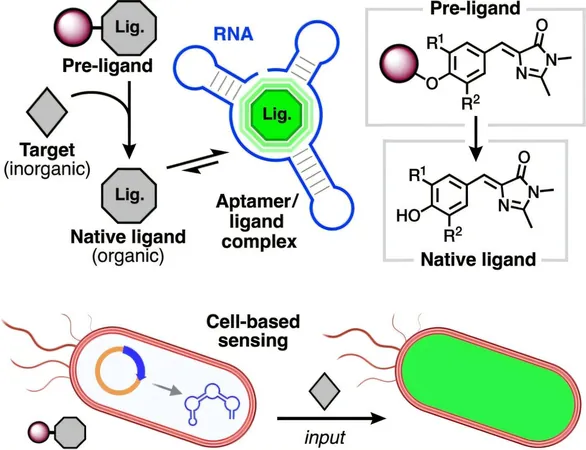
Revolutionary RNA Transformation Unlocks New Era in Biosensing for Human Health!
2025-04-07
Author: Yu
Introduction
In a groundbreaking advancement in biotechnology, scientists at Rutgers University-New Brunswick have successfully transformed RNA, a vital biological molecule found in all living cells, into an innovative biosensor capable of detecting minute concentrations of chemicals that are crucial to human health. This pioneering research holds promise not only for environmental monitoring but also for the early diagnosis of life-threatening conditions such as neurological disorders, cardiovascular diseases, and cancer.
The Vision of Future Health Screenings
Imagine a future where routine hospital visits involve patients providing their own cellular samples for health screenings. Enver Cagri Izgu, an assistant professor in the Department of Chemistry and Chemical Biology at Rutgers, envisions a system where 'technology can convert these cells into sensor cells without altering their natural physiology.' Once these bioengineered cells are reintroduced into a patient's body, they would work harmoniously without any risk of rejection, continuously relaying critical information about harmful chemicals or early signs of disease.
Innovative Research Publication
In their recent publication in the prestigious journal *Angewandte Chemie International Edition*, Izgu and his team unveiled how they engineered RNA within bacterial cells, enabling both the original and subsequent generations to detect specific chemicals. The substances targeted include fleeting inorganic compounds that play pivotal roles in health and disease. These findings are particularly significant as traditional RNA does not typically engage with such chemicals, making their detection through complex genetic circuits an arduous task.
The Role of RNA in Detection
Scientists have long been exploring the multifaceted roles of RNA in biological systems, revealing that it can bind with small molecules to emit light. This remarkable property, first identified in 2011, served as inspiration for Izgu's team to enhance the capabilities of RNA beyond its known functions. 'We harnessed our expertise in chemistry to develop RNA as a sensor for vital yet short-lived inorganic compounds like hydrogen sulfide and hydrogen peroxide,' Izgu explained. Their detection process involves a small receptor molecule that first interacts with these chemicals, linking it to a specific RNA sequence that subsequently emits light at a designated wavelength.
Testing with Escherichia coli
Testing their innovative method in *Escherichia coli*—a standard model organism—they demonstrated the ability to sense critical chemicals under laboratory conditions, including variations in hydrogen sulfide and hydrogen peroxide production seen in various disease states.
Implications of the Research
The implications of this research are immense. As hydrogen sulfide and hydrogen peroxide levels fluctuate in response to cancer and other serious illnesses, having the capability to monitor these changes in real-time could revolutionize diagnostics and patient care.
Translating Research into Medical Context
Izgu and his team aspire to translate their findings into a medical context by adapting human cells into sensors with the same proficiency demonstrated in their bacterial models. This endeavor represents a transformative leap forward in biosensing technology, potentially paving the way for earlier interventions and more personalized treatment strategies for myriad health issues.
Conclusion
Stay tuned as this exciting story develops and watch for potential breakthroughs that could redefine our approach to health diagnostics!




 Brasil (PT)
Brasil (PT)
 Canada (EN)
Canada (EN)
 Chile (ES)
Chile (ES)
 Česko (CS)
Česko (CS)
 대한민국 (KO)
대한민국 (KO)
 España (ES)
España (ES)
 France (FR)
France (FR)
 Hong Kong (EN)
Hong Kong (EN)
 Italia (IT)
Italia (IT)
 日本 (JA)
日本 (JA)
 Magyarország (HU)
Magyarország (HU)
 Norge (NO)
Norge (NO)
 Polska (PL)
Polska (PL)
 Schweiz (DE)
Schweiz (DE)
 Singapore (EN)
Singapore (EN)
 Sverige (SV)
Sverige (SV)
 Suomi (FI)
Suomi (FI)
 Türkiye (TR)
Türkiye (TR)
 الإمارات العربية المتحدة (AR)
الإمارات العربية المتحدة (AR)